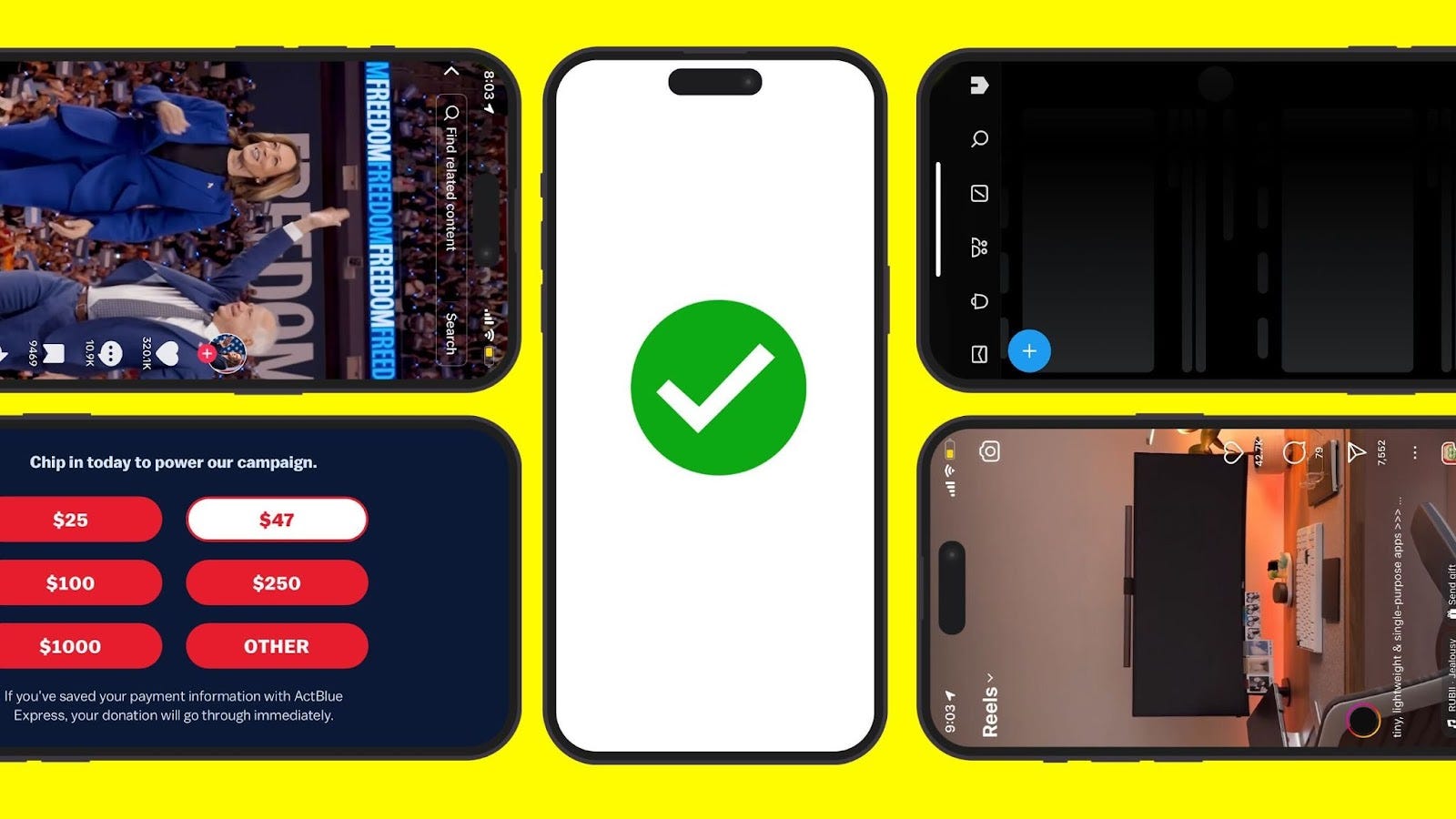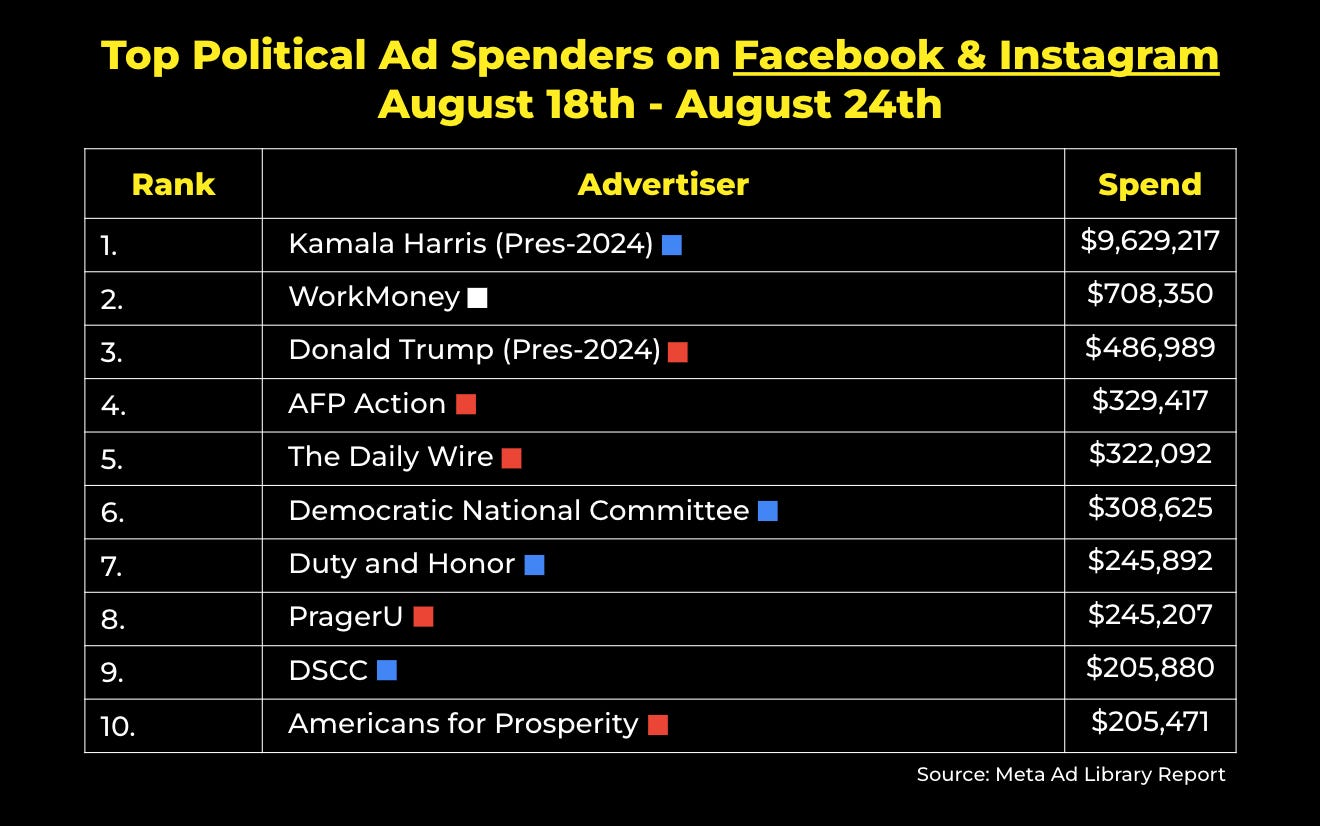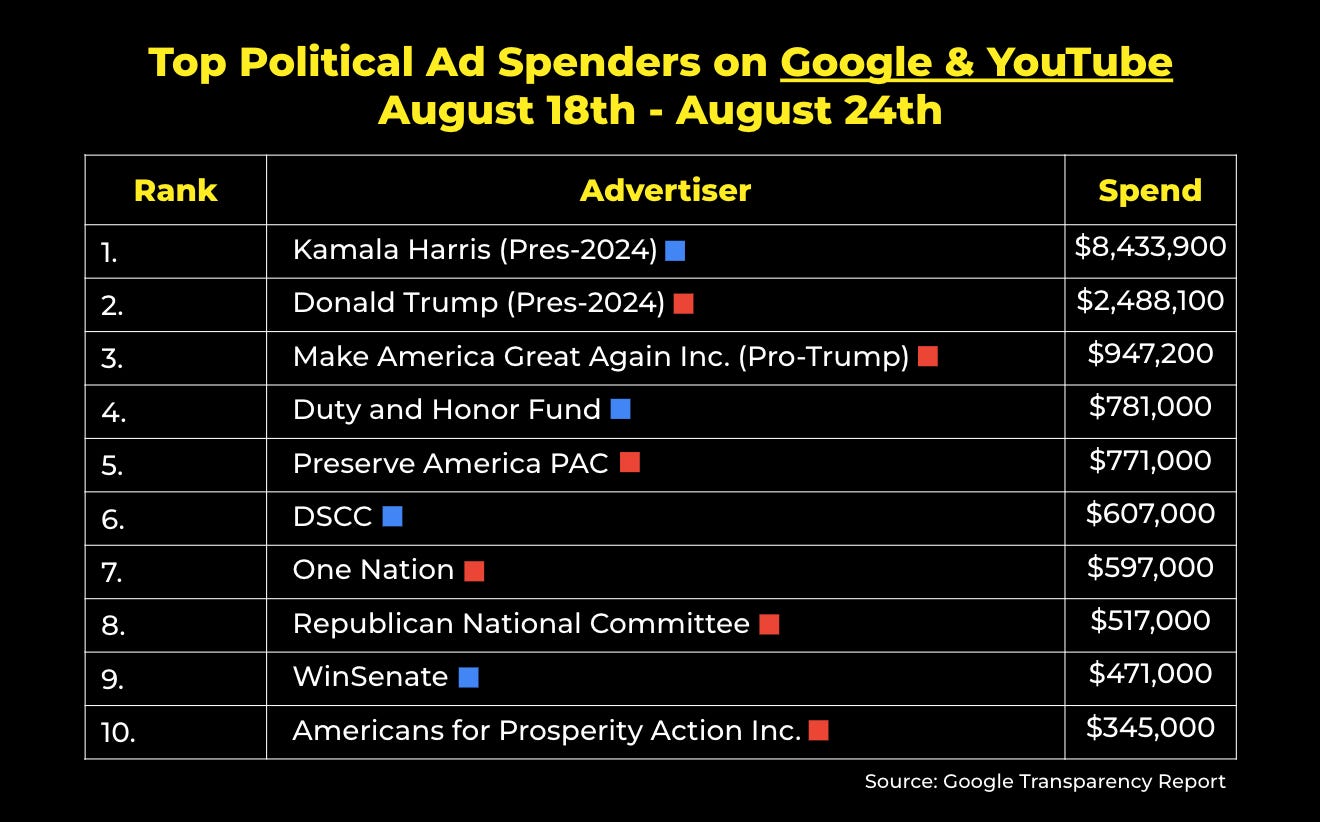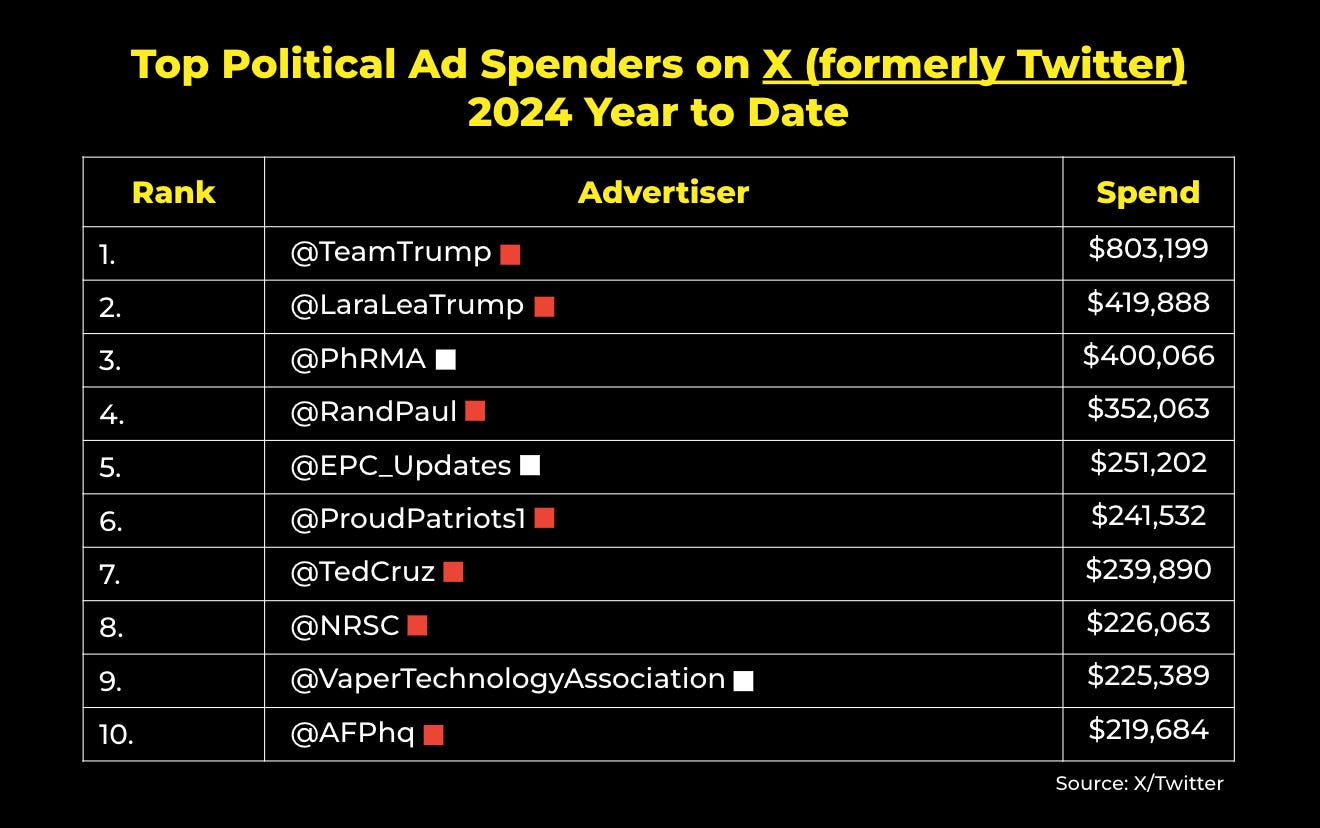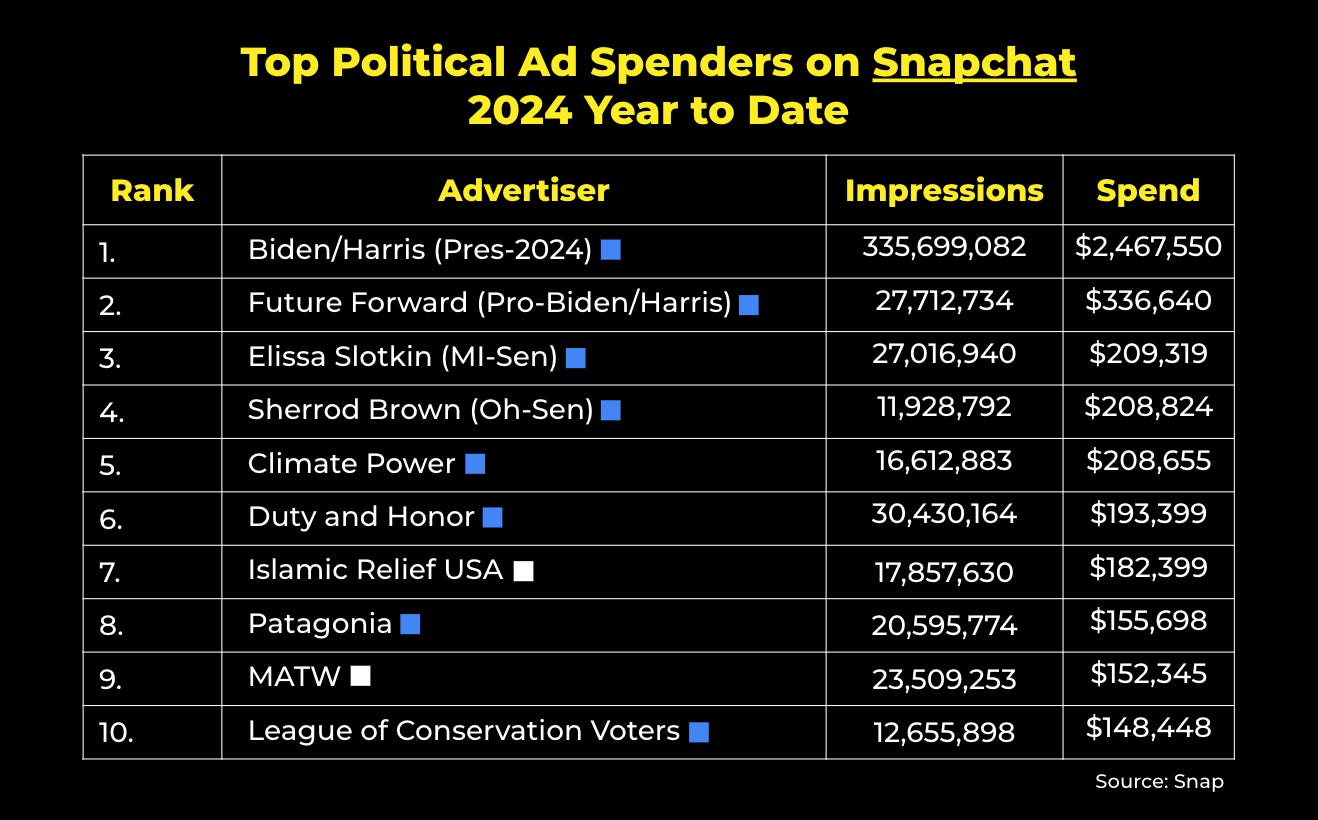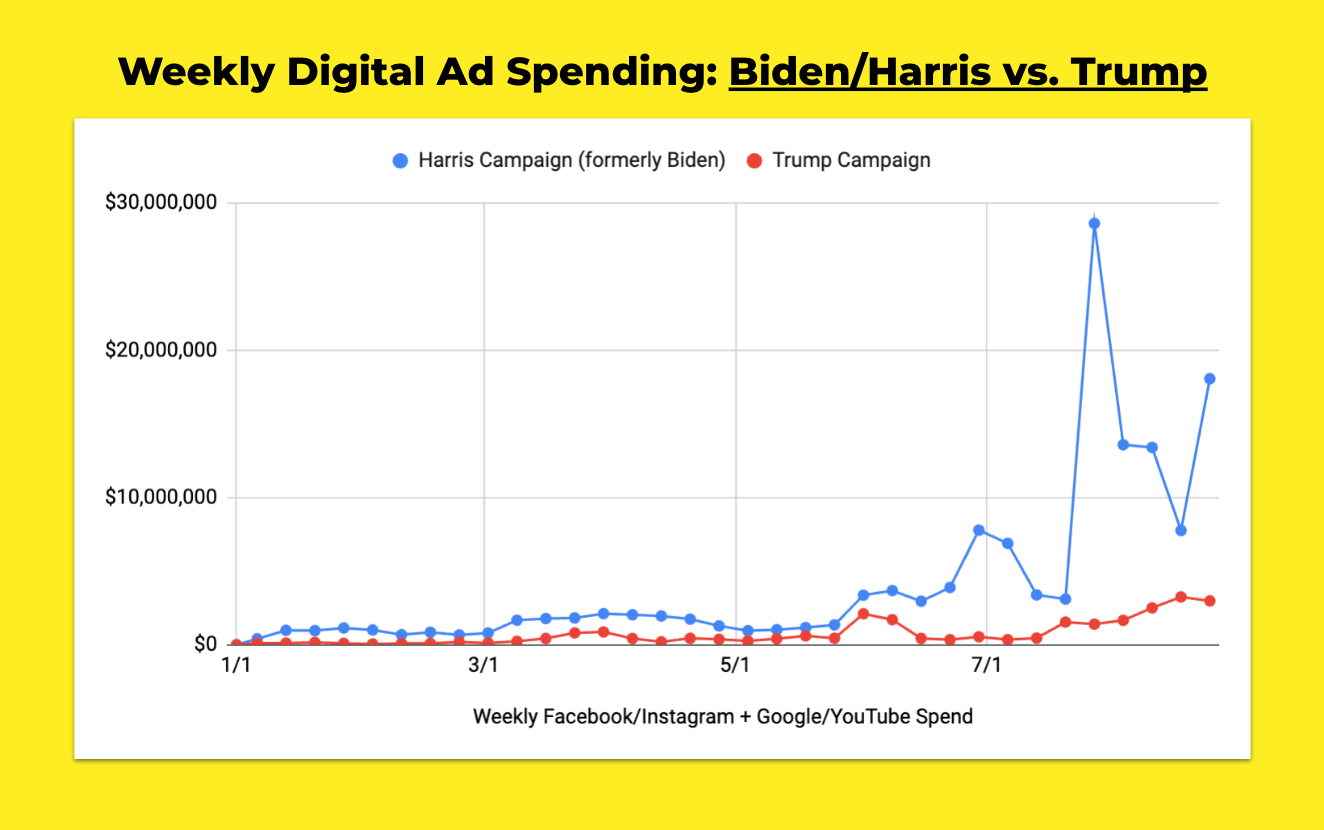👋 Welcome to FWIW, the leading newsletter tracking digital spending, strategy, and trends in our elections. You’re currently a free subscriber to FWIW - in order to read our full archive of past issues, upgrade your subscription here >> The six online trends we’re watching ahead of Election DayLabor Day traditionally marks the start of the real campaign season. Here are six things we’ll be watching over the next 10 weeks.FWIW, this week’s newsletter is sponsored by Social Goods Happy Labor Day weekend, a time that is traditionally considered the beginning of General Election Season. We hope you’re taking some time off on Monday. For their part, the Harris and Trump campaigns are moving full speed ahead and have just ten weeks to reach the voters they need by every method imaginable - online and off. As we look ahead to November, these are six of the major online trends that we think will impact elections up and down the ballot: #1. Democrats’ Massive Spending Advantage Look no further than the most competitive U.S. Senate races, where Republicans have made the decision to exclusively focus on old-school television ads, instead of online platforms where a majority of voters spend their time. We recently found that one prominent GOP Senate candidate in battleground Michigan had spent as little as $10,000 online compared to his Democratic rival’s $2 million. In the presidential race, the spending disparity is similar: The Harris campaign (previously Biden campaign) has outspent Trump on Google + Meta platforms by $142 million to $25 million. While much of this spending thus far has been on fundraising ads, both campaigns are now shifting over to buying ads that educate, persuade, and mobilize voters in key battleground states. #2. The Great TikTok Vibe Shift of 2024 Back when President Biden was atop the ticket, the vibes on TikTok for his campaign weren’t so great. According to an April report in Puck, pro-Trump content was dominating the political discourse on the platform, and the Trump campaign itself had started accumulating many more views, likes, and followers than Team Biden. Then, the vibes shifted. When Biden bowed out and Vice President Harris became the nominee, creators on the platform came out of the woodwork to post supportive content and wild memes boosting her candidacy. Using social analytics platform Zelf to track sentiment of TikTok posts each week, we can confidently say that pro-Harris and anti-Trump content is now the norm on the app. It remains to be seen how long can Harris ride that wave of enthusiasm and support. #3. Campaigns Lean into Creators In 2020, the Biden campaign and a few others started to experiment with online creator engagement at scale. This cycle, that type of work has become supercharged. Online messengers with millions of followers on platforms like YouTube, Instagram, and TikTok have been engaged by the White House and received special treatment at the DNC. It’s not just the Democrats; the Trump campaign has repeatedly engaged with online personalities too, from Jake Paul to Adin Ross. In fact, an entire cottage industry of political influencer intermediary firms has popped up in recent years - from Social Currant, Good Influence, Pallete MGMT, and Vocal Media on the Left to Influenceable on the Right. How much will this type of creator engagement help both sides reach sought-after, disengaged voters this fall? #4. Harris’ History-making Haul No political candidate in American history has ever raised as much money online as Kamala Harris. Since announcing her candidacy on July 21, her team has raised more than $540 million dollars, much of which came from grassroots donors online. That eye-popping sum is about more than just cash – it's another measure of serious grassroots enthusiasm among Democrats. If millions of people are willing to chip in $5 or $10 dollars to support Harris, they’re likely willing to get their friends to vote in November. #5. Toxic Twitter (X) Remains on Top Like it or not, the platform formerly known as Twitter still exists - a fact that seemed uncertain when the social media company was settling into regular cycles of chaos over a year ago. Journalists and political influencers have relied on Elon Musk’s app to track every breaking political news event this year - from Biden’s triumph at the State of the Union to his disastrous debate performance to the campaign veepstakes and both parties’ conventions. Twitter may not be real life, but The Very Serious People who work in politics and journalism continue to use it on a daily basis for sourcing their stories and distributing their hot takes. #6. Facebook Retreats Into The Shadows This election cycle, Facebook (and its parent company Meta) has attempted to stay far away from politics. Shuttering its transparency app CrowdTangle this month, banning political ads in the campaign’s final weeks, and vowing to deprioritize political content on Instagram and Threads, the company has taken enormous steps to avoid public relations disasters resulting from political misuse of its platforms. How will Facebook’s moves impact voters’ ability to get accurate election information? Will shady LLCs and networks of lesser-known Facebook pages continue to reach Americans with questionable content? Digital ad spending, by the numbers:FWIW, political advertisers spent just over $26 million on Facebook and Instagram ads last week. These were the top ten spenders nationwide: The powerful Teamsters union may be having a bit of internal drama this cycle, but a new group called Teamsters Against Trump PAC started running Facebook + Instagram ads with a clear ask to help them elect Kamala Harris over Donald Trump. Meanwhile, political campaigns spent $23.4 million on Google and YouTube ads last week. Here were the top ten spenders nationwide: The Harris campaign has kicked off an advertising blitz focused on Project 2025, highlighting the authoritarian policy playbook to swing-state voters. Here’s a sample of what they’re running: 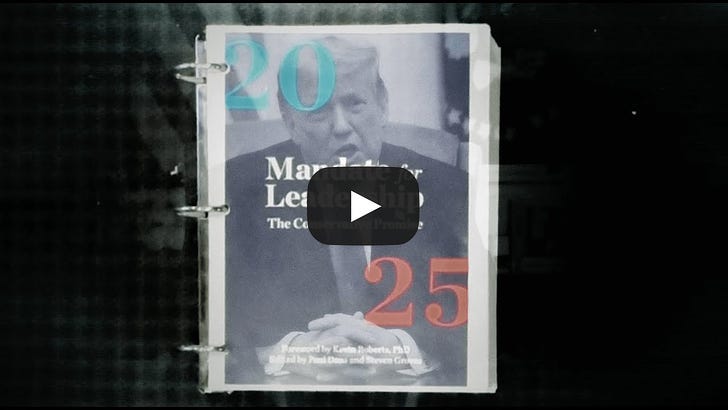 Meanwhile, the Trump campaign is running new YouTube ads targeting battleground state voters vowing to end taxes on social security benefits and eliminate taxes on tips for service workers. On X (formerly Twitter), political advertisers in the U.S. have spent $8.8 million on ads year to date. Here are the top spenders: One of the top advertisers on Snapchat in recent weeks has been the @VaperTechnologyAssociation, which is running ads that criticize government overreach and assert “the freedom to vape.” It’s unclear if these ads are related to this somewhat sinister GOP ad scheme around menthol cigarettes… but it seems Big Nicotine is not sitting out this election. …and lastly, on Snapchat, political advertisers in the U.S. have spent $5.6 million on ads year to date. Here are the top spenders: Merch that makes a statement
Presidential head-to-headFWIW, here’s how weekly digital ad spending (Facebook/Instagram, Google/YouTube) compares between the Trump and Harris (formerly Biden) campaigns year-to-date: The Harris campaign spent over $18 million on digital ads this past week, which is their second-highest digital ad weekly spend of 2024. They’re also getting pretty creative with some of these spends and trying out different strategies. For example, they are running fundraising ads directly from Barack Obama’s Facebook page, and they’re using another new campaign-related Facebook page called “Memericans” which is currently running ads about Project 2025. By comparison, Team Trump spent a little under $3 million on digital ads this past week (see the Dem’s massive spending advantage section above 👀). What’s happening on TikTok?This week, content from the DNC continued to drive the the political conversation on TikTok, and we also found lots of content contrasting the two vice presidential candidates. Read all about it in this week’s issue of #FYP: More from around the internet:
That’s it for FWIW this week. This email was sent to 23,053 readers. If you enjoy reading this newsletter each week, would you mind sharing it on Twitter or Threads? Have a tip, idea, or feedback? Reply directly to this email. |

